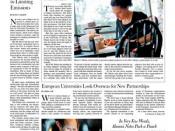Summary Paper
Culture, Not Race,
Explains Human
Diversity
"We... have to stop teaching or accepting the idea that humans are divided
into three races - Caucasian, Negroid, and Mongoloid
- an idea that is at least 50 years out of date."
Culture, Not Race, Explains Human Diversity, Mark Nathan Cohen,
Chronicle of Higher Education, April 17, 1998, pp.B4-B5.
The term race refers to a biological subdivision of a species. At one time, scientists held that there were as few as three such subdivisions in the species Homo sapiens: Caucasoid, Negroid, and Mongoloid. Mark Anthony Cohen points out that this is an antiquated view, yet it lingers as a common belief in society. Popular everyday awareness of race is transmitted from generation to generation through cultural learning. Cohen maintains that greater efforts need to be made in educating the public as to the fact that we are all of the same race, and that what we perceive as racial differences are in fact, largely cultural differences.
While anthropologists continue to study how and why humans vary biologically, it is apparent that human populations differ from one another much less than do populations in other species because we use our cultural, rather than our physical differences to aid us in adapting to various environments. This fact is important in understanding why minorities within a country might exhibit what is typically called "racial traits". Cohen states, "The key point is that what we see as 'racial' differences in behavior may reflect the fact that people have different values, make different choices, operate within different cultural 'grammars,' and categorize things (and therefore think) in different ways."
Cohen states, "Besides teaching our students about the importance of culture, we need to revive the anthropological concept of cultural relativism..." He then goes on to...


